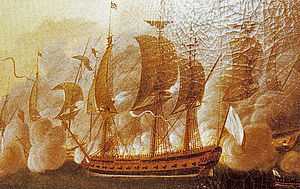French frigate Hermione (1779)
 Hermione in the Naval battle of Louisbourg, by Auguste-Louis de Rossel de Cercy | |
| Career (France) | |
|---|---|
| Name: | Hermione |
| Builder: | Rochefort[1] |
| Laid down: | March 1778[1] |
| Launched: | 28 April 1779[1] |
| In service: | June 1779[1] |
| Fate: | Ran aground and wrecked due to a navigation error of her pilot at Croisic on 20 September 1793[1] |
| General characteristics | |
| Class and type: | Concorde class 12-pounder frigate |
| Displacement: | 550 tons; 1160 ton burthen[1] |
| Length: | 44.2 m (145 ft)[1] |
| Beam: | 11.24 m (36.9 ft)[1] |
| Draught: | 5.78 m (19.0 ft)[1] |
| Complement: | 255 |
| Armament: | 32 guns:
|
The Hermione was a 12-pounder Concorde class frigate of the French Navy. She became famous when she ferried General Lafayette to the United States in 1780 for extension and spread of the war in the American Independence Movements 1754–1763 on behalf of the French interest. She grounded and was wrecked in 1793.
In 1997, construction of a replica ship started in Rochefort, Charente-Maritime, France; the new ship is named Hermione.
Career

Hermione was built in eleven months at Rochefort, by the shipwright Henri Chevillard as a light (French: légère) frigate, fast and maneuverable. Between May and December 1779 she underwent successful sea trials in the Gulf of Gascony under the command of Lieutenant de Latouche.
General La Fayette embarked at Rochefort on 11 March 1780 and arrived in Boston on 28 April carrying the then-secret news that he had secured French reinforcements (5,500 men and 5 frigates) for Washington. She got underway again on 2 June and suffered serious damage in the fierce but indecisive Action of 7 June 1780 against the 32-gun HMS Iris, under James Hawker.
Hermione received the American Congress on board in May 1781. She fought several times in company with the Astrée, commanded by Lapérouse, especially at the Naval battle of Louisbourg on 21 July 1781.
After the end of the American Revolutionary War, Hermione returned to France in February 1782. She then formed part of a squadron sent to India to help Suffren against the British. However peace was declared and the ship returned to Rochefort in April 1784.
Fate
Again in service against the British, on 20 September 1793,[2] she ran aground off Croisic, and was then wrecked by heavy seas. The court-martial consecutive to the wreck found her pilot, Guillaume Guillemin du Conquet, responsible for her loss; her commanding officer, Captain Martin, was honourably acquitted.[1]
Reconstruction
In 1997 a reconstruction project started in Rochefort. The new ship is named L'Hermione.
In April 2015, a full-size replica of the Hermione frigate plans to make a return voyage to the United States from Rochefort, France, according to a November 10, 2013 report in The New York Times. The ship will stop at ports from Yorktown VA, Mount Vernon VA, Alexandria VA, Baltimore MD, Annapolis MD, Philadelphia PA , New York City, Boston MA, New Port RI, Castine ME, and Nova Scotia. She will make her final U.S. stop in Castine, Maine, on Bastille Day, before heading to Halifax and back to France. L'Hermione’s itinerary is meant to reaffirm the historic relationship between the United States and France.
References
Bibliography
- Archbold, Rick. Hindenburg: An Illustrated History. Toronto: Viking Studio/Madison Press, 1994. ISBN 0-670-85225-2.
- Jean-Marie Ballu, L'Hermione, l'aventure de sa reconstruction, Editions du Gerfaut, 2007 ISBN 978-2-35191-018-4
- Emmanuel de Fontainieu, Yves Gaubert, L'Hermione, de Rochefort à la gloire américaine, Editions de Monza, 2002 ISBN 978-2-908071-95-5
- Robert Kalbach, Jean-Luc Gireaud, L'Hermione, Frégate des Lumières, Dervy, 2004 ISBN 978-2-84454-319-6
- Duggan, John. LZ 129 "Hindenburg": The Complete Story. Ickenham, UK: Zeppelin Study Group, 2002. ISBN 0-9514114-8-9.
- Roche, Jean-Michel (2005). Dictionnaire des bâtiments de la flotte de guerre française de Colbert à nos jours 1. Group Retozel-Maury Millau. ISBN 978-2-9525917-0-6.
- Troude, Onésime-Joachim (1867). Batailles navales de la France (in French) 2. Challamel ainé.
- James M. Volo, Blue Water Patriots: The American Revolution Afloat, Greenwood Publishing Group, 2007 ISBN 978-0-275-98907-1
- Winfield, Rif (2007). British Warships of the Age of Sail 1714–1792: Design, Construction, Careers and Fates. Seaforth. ISBN 1-86176-295-X.
- Airships.net LZ-129 Hindenburg
External links
- "75 Years Since The Hindenburg Disaster" The Atlantic, May 8, 2012
- L’Hermione, first departure in salt water !
- "Hindenburg – End Of A Successful Voyage" (Standard 4:3) (1937), Pathgrams (film shows docking team, passengers)
- Website of the reconstruction project
- Naval History : l'Hermione (French)
- L'Hermione - the frigate of enlightenment
- New York Times report of reconstruction project
- The Friends of Lafayette-Hermione in America, a non-profit group, supports this reconstruction and the planned voyage.